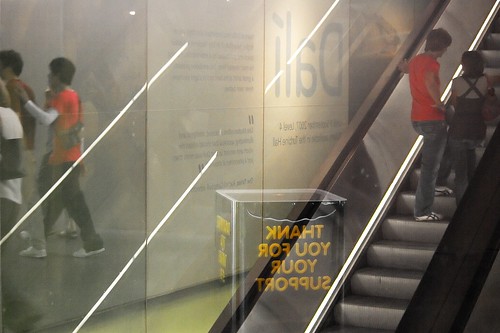Seriousness Abused
 Tate I, photo by Flickr user Martino's Doodles. Click image to visit the Flickr page.
Tate I, photo by Flickr user Martino's Doodles. Click image to visit the Flickr page.
It's easy to label me as an artist: I paint. I paint pictures. I paint pictures of people. Easy, right? I don't happen to be particularly turned on by conceptual art, or art that's deliberately obfuscated, or art objects overshadowed by the artist's mission to "break boundaries" and "challenge preconceptions."
Before you click away, conceptual artists, please hear me: I love you. And also you guys, who like to paint pictures of kitties and geraniums: I love you, too. Art is art, and it takes all kinds. There, I've said my thing.
Art can be difficult for us to swallow. As Dan Fox writes in this editorial for Frieze Magazine, difficult art has become the norm in the art world.
Boundaries are ‘broken down’ and ‘preconceptions challenged’ so often as to make subversion and radicality seem like a mandatory daily chore rather than a blow to the status quo. They perpetuate old-fashioned notions, such as that of the artist visionary liberating the masses from mental enslavement by bourgeois values. Overuse has made these words sound strangely toothless, for what’s at stake in the art is often less important (but not necessarily without value) than the language suggests.
Of course, what constitutes "the art world" is an ever-shifting tapestry of popular opinion, preconceptions, and nebulous reputations. (Perhaps some boundary-breaking is warranted here.) It seems one is either in it or not. It's hard to say when exactly an artist becomes part of the art world, we usually rest upon the consensus that they have arrived. This vague notion of the art world as an establishment points out our links to the tired cliche of the artist as revolutionary. At what point does the liberator become the institution?
This is just one of the many questions I asked myself while reading Fox's article (via Kristin Anderson). I didn't come up with many answers. I'll continue to think about how deeply the following resonates with me:
You have to understand the pieties: the weight of an artist’s monograph or how many times their name crops up on e-flux announcements; someone’s preference for reading October rather than frieze; the internationalism of the contemporary art world – some romantic residue of the idea that, if you travel regularly by plane, you must be high-powered because your business reaches far outside your locality; artist names exchanged as collateral by those jockeying for position in the marketplace of curating or criticism. These are the little curlicues that adorn the edifice of the professional arts establishment.

